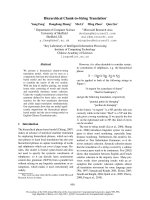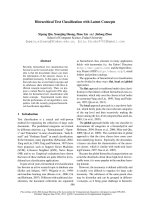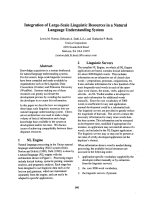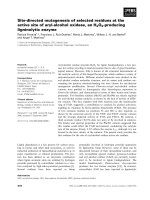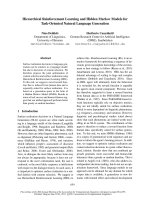Báo cáo khoa học: "Hierarchical Directed Acyclic Graph Kernel: Methods for Structured Natural Language Data" pptx
Bạn đang xem bản rút gọn của tài liệu. Xem và tải ngay bản đầy đủ của tài liệu tại đây (140.31 KB, 8 trang )
Hierarchical Directed Acyclic Graph Kernel:
Methods for Structured Natural Language Data
Jun Suzuki, Tsutomu Hirao, Yutaka Sasaki, and Eisaku Maeda
NTT Communication Science Laboratories, NTT Corp.
2-4 Hikaridai, Seika-cho, Soraku-gun, Kyoto, 619-0237 Japan
jun, hirao, sasaki, maeda @cslab.kecl.ntt.co.jp
Abstract
This paper proposes the “Hierarchical Di-
rected Acyclic Graph (HDAG) Kernel” for
structured natural language data. The
HDAG Kernel directlyacceptsseveral lev-
els of both chunks and their relations,
and then efficiently computes the weighed
sum of the number of common attribute
sequences of the HDAGs. We applied the
proposed method to question classifica-
tion and sentence alignment tasks to eval-
uate its performance as a similarity mea-
sure and a kernel function. The results
of the experiments demonstrate that the
HDAG Kernel is superior to other kernel
functions and baseline methods.
1 Introduction
As it has become easy to get structured corpora such
as annotated texts, many researchers have applied
statistical and machine learning techniques to NLP
tasks, thus the accuracies of basic NLP tools, such
as POS taggers, NP chunkers, named entities tag-
gers and dependency analyzers, have been improved
to the point that they can realize practical applica-
tions in NLP.
The motivation of this paper is to identify and
use richer information within texts that willimprove
the performance of NLP applications; this is in con-
trast to using feature vectors constructed by a bag-
of-words (Salton et al., 1975).
We now are focusing on the methods that use nu-
merical feature vectors to represent the features of
natural language data. In this case, since the orig-
inal natural language data is symbolic, researchers
convert the symbolic data into numeric data. This
process, feature extraction, is ad-hoc in nature and
differs with each NLP task; there has been no neat
formulation for generating feature vectors from the
semantic and grammatical structures inside texts.
Kernel methods (Vapnik, 1995; Cristianini and
Shawe-Taylor, 2000) suitable for NLP have recently
been devised. Convolution Kernels (Haussler, 1999)
demonstrate how to build kernels over discrete struc-
tures such as strings, trees, and graphs. One of the
most remarkable properties of this kernel method-
ology is that it retains the original representation
of objects and algorithms manipulate the objects
simply by computing kernel functions from the in-
ner products between pairs of objects. This means
that we do not have to map texts to the feature
vectors by explicitly representing them, as long as
an efficient calculation for the inner products be-
tween a pair of texts is defined. The kernel method
is widely adopted in Machine Learning methods,
such as the Support Vector Machine (SVM) (Vap-
nik, 1995). In addition, kernel function
has been described as a similarity function that
satisfies certain properties (Cristianini and Shawe-
Taylor, 2000). The similarity measure between texts
is one of the most importantfactorsfor some tasks in
the application areas of NLP such as Machine Trans-
lation, Text Categorization, Information Retrieval,
and Question Answering.
This paper proposes the Hierarchical Directed
Acyclic Graph (HDAG) Kernel. It can handle sev-
eral of the structures found within texts and can cal-
culate the similarity with regard to these structures
at practical cost and time. The HDAG Kernel can be
widely applied to learning, clustering and similarity
measures in NLP tasks.
The following sections define the HDAG Kernel
and introduce an algorithm that implements it. The
results of applying the HDAG Kernel to the tasks
of question classification and sentence alignment are
then discussed.
2 Convolution Kernels
Convolution Kernels were proposed as a concept of
kernels for a discrete structure. This framework de-
fines a kernel function between input objects by ap-
plying convolution “sub-kernels” that are the kernels
for the decompositions (parts) of the objects.
Let
be a positive integer and
be nonempty, separable metric spaces. This paper
focuses on the special case that are
countable sets. We start with as a composite
structure and
as its “parts”, where
. is defined as a relation on the set
such that is true if are the
“parts” of . is defined as
Suppose , be the parts of with
, and be the parts of with
. Then, the similarity be-
tween and is defined as the following general-
ized convolution:
(1)
We note that Convolution Kernels are abstract con-
cepts, and that instances of them are determined by
the definition of sub-kernel . The Tree
Kernel (Collins and Duffy, 2001) and String Subse-
quence Kernel (SSK) (Lodhi et al., 2002), developed
in the NLP field, are examples of Convolution Ker-
nels instances.
An explicit definition of both the Tree Kernel and
SSK is written as:
(2)
Conceptually, we enumerate all sub-structures oc-
curring in and , where represents the to-
tal number of possible sub-structures in the ob-
jects.
, the feature mapping from the sample
space to the feature space, is given by
In the case of the Tree Kernel, and be trees.
The Tree Kernel computes the number of common
subtrees in two trees and . is defined as
the number of occurrences of the ’th enumerated
subtree in tree .
In the case of SSK, input objects and are
string sequences, and the kernel function computes
the sum of the occurrences of ’th common subse-
quence weighted according tothe length ofthe
subsequence. These two kernels make polynomial-
time calculations, based on efficient recursive cal-
culation, possible, see equation (1). Our proposed
method uses the framework of Convolution Kernels.
3 HDAG Kernel
3.1 Definition of HDAG
This paper defines HDAG as a Directed Acyclic
Graph (DAG) with hierarchical structures. That is,
certain nodes contain DAGs within themselves.
In basic NLP tasks, chunkingand parsing are used
to analyze the text semantically or grammatically.
There are several levels of chunks, such as phrases,
named entities and sentences, and these are bound
by relation structures, such as dependency structure,
anaphora, and coreference. HDAG is designed to
enable the representation of all of these structures
inside texts, hierarchical structures for chunks and
DAG structures for the relations of chunks. We be-
lieve this richer representation is extremely useful to
improve the performance of similarity measure be-
tween texts, moreover, learning and clustering tasks
in the application areas of NLP.
Figure 1 shows an example of the text structures
that can be handled by HDAG. Figure 2 contains
simple examples of HDAG that elucidate the calcu-
lation of similarity.
As shown in Figures 1 and 2, the nodes are al-
lowed to have more than zero attributes, because
nodes in texts usually have several kinds of at-
tributes. For example, attributes include words, part-
of-speech tags, semantic information such as Word-
is of
PERSON
NNP NNP VBZ
word named entity NP chunk
dependency structure
sentence
coreference
.
Jun-ichi Tsujii general chair ACL2003the
He is one of the most famous
Junichi Tsujii is the Gereral Chair of ACL2003.
He is one of the most famous researchers in the NLP field.
:node
:direct link
DT JJ NN IN NNP
NP
NP
PRP VBZ CD IN DT RBS JJ
NP
NP
ORG
attribute:
words
Part-of-speech tags
NP chunk
class of NE
Figure 1: Example of the text structures handled by
HDAG
p1
p2
p5
p4p3
G1
G2
q1 q6
q4
q3
N
V
a
b
adc
N
e b
ca d
q8q2 q5 q7
p6 p7
NP
NP
Figure 2: Examples of HDAG structure
Net, and class of the named entity.
3.2 Definition of HDAG Kernel
First of all, we define the set of nodes in HDAGs
and as and , respectively, and repre-
sent nodes in the graph that are defined as
and ,
respectively. We use the expression
to represent the path from to through .
We define “attribute sequence” as a sequence of
attributes extracted from nodes included in a sub-
path. The attribute sequence is expressed as ‘A-B’
or ‘A-(C-B)’ where ( ) represents a chunk. As a ba-
sic example of the extraction of attribute sequences
from a sub-path, in Figure 2 contains the
four attribute sequences ‘e-b’, ‘e-V’, ‘N-b’ and ‘N-
V’, which are the combinations of all attributes in
and . Section 3.3 explains in detail the method of
extracting attribute sequences from sub-paths.
Next, we define “terminated nodes” as those that
do not contain any graph, such as
, ; “non-
terminated nodes” are those that do, such as , .
Since HDAGs treat not only exact matching of
sub-structures but also approximate matching, we
allow node skips according to decay factor
when extracting attribute sequences from the
sub-paths. This framework makes similarity evalua-
tion robust; the similar sub-structures can be eval-
uated in the value of similarity, in contrast to ex-
act matching that never evaluate the similar sub-
structure. Next, we define parameter (
) as the number of attributes combined inthe
attribute sequence. When calculating similarity, we
consider only combination lengths of up to .
Given the above discussion, the feature vector of
HDAG is written as ,
where represents the explicit feature mapping of
HDAG and represents the number of all possible
attribute combinations. The value of is the
number of occurrences of the ’th attribute sequence
in HDAG ; each attribute sequence is weighted ac-
cording to the node skip. The similarity between
HDAGs, which is the definition of the HDAG Ker-
nel, follows equation (2) where input objects
and
are and , respectively. According to this ap-
proach, the HDAG Kernel calculates the inner prod-
uct of the common attribute sequences weighted ac-
cording to their node skips and the occurrence be-
tween the two HDAGs, and .
We note that, in general, if the dimension of the
feature space becomes very high or approaches in-
finity, it becomes computationally infeasible to gen-
erate feature vector explicitly. To improve the
reader’s understanding of what the HDAG Kernel
calculates, before we introduce our efficient calcu-
lation method, the next section details the attribute
sequences that become elements of the feature vec-
tor if the calculation is explicit.
3.3 Attribute Sequences: The Elements of the
Feature Vector
We describe the details of the attribute sequences
that are elements of the feature vector of the HDAG
Kernel using
and in Figure 2.
The framework of node skip
We denote the explicit representation of a node
skip by ”
”. The attribute sequences in the sub-path
under the “node skip” are written as ‘a- -c’. It costs
to skip a terminated node. The cost of skipping a
Table 1: Attribute sequences and the values of nodes
and
sub-path a. seq. val.
NP 1
a-
N-
c-
-b
a-b 1
N-b 1
c-b 1
sub-path a. seq. val.
NP 1
( - )-a
(c- )-
( -d)-
(c-d)-
(c- )-a
( -d)-a
(c-d)-c 1
non-terminated node is the same as skipping all the
graphs inside the non-terminated node. We intro-
duce decay functions , and ; all
are based on decay factor . represents the
cost of node skip . For example,
represents the cost of node skip and that
of ; is the cost of just node
skip . represents the sum of the multiplied
cost of the node skips of all of the nodes that have a
path to , that is the sum cost of both
and that have a path to , .
represents the sum of the multiplied cost of
the node skips of all the nodes that has a path
to. represents the cost of node skip
where has a path to .
Attribute sequences for non-terminated nodes
We define the attributes of the non-terminated
node as the combinations of all attribute sequences
including the node skip. Table 1 shows the attribute
sequences and values of and .
Details of the elements in the feature vector
The elements of the feature vector are not consid-
ered in any of the node skips. This means that ‘A-
-B-C’ is the same element as ‘A-B-C’, and ‘A- - -
B-C’ and ‘A- -B- -C’ are also the same element as
‘A-B-C’. Considering the hierarchical structure, it is
natural to assume that ‘(N- )-(d)-a’ and ‘(N- )-(( -
d)-a)’ are different elements. However, in the frame-
work of the node skip and the attributes of the non-
terminated node, ‘(N- )-( )-a’ and ‘(N- )-(( - )-a)’
are treated as the same element. This framework
Table 2: Similarity values of and in Figure 2
att. seq. value att. seq. value
NP 1 NP 1 1
N
1 N 1 1
a 2 a 1 2
b
1 b 1 1
c 1 c 1 1
d
1 d 1 1
(N- )-( )-a (N- )-(( - )-a)
N-b 1 N-b 1 1
(N- )-(d) (N- )-(( -d)- )
( -b)-( )-a ( -b)-(( - )-a)
( -b)-(d) ( -b)-(( -d)- )
(c- )-( )-a ((c- )-a)
(c- )-(d) c-d 1
(d)-a 1 (c- )-a
(N-b)-( )-a (N-b)-(( - )-a)
(N-b)-(d) 1 (N-b)-(( -d)- )
achieves approximate matching of the structure au-
tomatically, The HDAG Kernel judges all pairs of
attributes in each attribute sequence that are inside
or outside the same chunk. If all pairs of attributes
in the attribute sequences are in the same condition,
inside or outside the chunk, then the attribute se-
quences judge as the same element.
Table 2 shows the similarity, the values of
, when the feature vectors are ex-
plicitly represented. We only show the common ele-
ments of each feature vector that appear in both
and , since the number of elements that appear in
only or becomes very large.
Note that, as shown in Table 2, the attribute se-
quences of the non-terminated node itself are not
addressed by the features of the graph. This is due
to the use of the hierarchical structure; the attribute
sequences of the non-terminated node come from
the combination of the attributes in the terminated
nodes. In the case of , attribute sequence ‘N- ’
comes from ‘N’ in . If we treat both ‘N- ’ in
and ‘N’ in , we evaluate the attribute sequence ‘N’
in twice. That is why the similarity value in Ta-
ble 2 does not contain ‘c- ’ in and ‘(c- )- ’ in ,
see Table 1.
3.4 Calculation
First, we determine , which returns the
sum of the common attribute sequences of the -
combination of attributes between nodes and .
if
otherwise
(3)
if and
if and
if and
otherwise
(4)
returns the number of common attributes
of nodes and , not including the attributes of
nodes inside and . We define function as re-
turning a set of nodes inside a non-terminated node
. means node is a terminated node.
For example, and .
We define functions , and
to calculate .
(5)
(6)
(7)
The boundary conditions are
if (8)
if (9)
if (10)
Function returns the set of nodes that have
direct links to node . means no nodes
have direct links to . and
.
Next, we define as representing the sum
of the common attribute sequences that are the -
combinations of attributes extracted from the sub-
paths whose sinks are and , respectively.
if
otherwise
(11)
Functions , and ,
needed for the recursive calculationof , are
written in the same form as , and
respectively, except for the boundary con-
dition of , which is written as:
if (12)
Finally, an efficient similarity calculation formula is
written as
(13)
According to equation (13), given the recursive
definition of
, the similarity between two
HDAGs can be calculated in time
1
.
3.5 Efficient Calculation Method
We will now elucidate an efficient processing algo-
rithm. First, as a pre-process, the nodes are sorted
under the following condition: all nodes that have
a path to the focused node and are in the graph in-
side the focused node should be set before the fo-
cused node. We can get at least one set of ordered
nodes since we are treating an HDAG. In the case
of
, we can get , , , , , , . We
can rewrite the recursive calculation formula in “for
loops”, if we follow the sorted order. Figure 3 shows
the algorithm of the HDAG kernel. Dynamic pro-
gramming technique is used to compute the HDAG
Kernel very efficiently because when following the
sorted order, the values that are needed to calculate
the focused pair of nodes are already calculated in
the previous calculation. We can calculate the table
by following the order of the nodes from left to right
and top to bottom.
We normalize the computed kernels before their
use within the algorithms. The normalization cor-
responds to the standard unit norm normalization of
1
We can easily rewrite the equation to calculate all combi-
nations of attributes, but the order of calculation time becomes
.
Algorithm HDAG Kernel n combination
for
i++
for ++
if and
foreach
foreach
for ++
+=
end
end
end
else if
foreach
+=
end
else if
foreach
+=
end
end
foreach
for ++
+=
+=
end
end
foreach
for ++
+=
+=
end
end
for ++
for ++
+=
+=
+=
end
end
end
end
return
Figure 3: Algorithm of the HDAG Kernel
examples in the feature space corresponding to the
kernel space (Lodhi et al., 2002).
(14)
4 Experiments
We evaluated the performance of the proposed
method in an actual application of NLP; the data set
is written in Japanese.
We compared HDAG and DAG (the latter had no
hierarchy structure) to the String Subsequence Ker-
nel (SSK) for word sequence, Dependency Structure
p1
p2
p5p4
p3
p6 p7
George Bush purchased a small interest in which baseball team ?
NNP NNP VBD DT JJ NN IN WDT NN NN
.
PERSON
NP
NP NPPP
Question: George Bush purchased a small interest in which baseball team ?
p8
p9
p11
p10
p12 p13 p14
p1 p5p4
p6 p7
George Bush purchased a small interest in which baseball team ?
VBD DT JJ NN IN WDT NN NN
.
PERSON
p8 p9 p10
(a) Hierarchical and Dependency Structure
(b) Dependency Structure
p2 p3
(c) Word Order
p1 p5p4
p6 p7
George Bush purchased a small interest in which baseball team ?
VBD DT JJ NN IN WDT NN NN
.
PERSON
p8 p9 p10p2 p3
Figure 4: Examples of Input Object Structure: (a)
HDAG, (b) DAG and DSK’, (c) SSK’
Kernel (DSK) (Collins and Duffy, 2001) (a special
case of the Tree Kernel), and Cosine measure for
feature vectors consisting of the occurrence of at-
tributes (BOA), and the same as BOA, but only the
attributes of noun and unknown word (BOA’)were
used.
We expanded SSK and DSK to improve the total
performance of the experiments. We denote them
as SSK’ and DSK’ respectively. The original SSK
treats only exact
string combinations based on pa-
rameter . We consider string combinations of up to
for SSK’. The original DSK was specifically con-
structed for parse tree use. We expanded it to be able
to treat the combinations of nodes and the free or-
der of child node matching.
Figure 4 shows some input objects for each eval-
uated kernel, (a) for HDAG, (b) for DAG and DSK’,
and (c) for SSK’. Note, though DAG and DSK’
treat the same input objects, their kernel calculation
methods differ as do the return values.
We used the words and semantic information of
“Goi-taikei” (Ikehara et al., 1997), which is similar
to WordNet in English, as the attributes of the node.
The chunks and their relations in the texts were an-
alyzed by cabocha (Kudo and Matsumoto, 2002),
and named entities were analyzed by the method
of (Isozaki and Kazawa, 2002).
We testedeach
-combination case withchanging
parameter from 0.1 through 0.9 in the step of 0.1.
Only the best performance achieved under parame-
ter is shown in each case.
Table 3: Results of the performance as a similarity
measure for question classification
1 2 3 4 5 6
HDAG - .580 .583 .580 .579 .573
DAG - .577 .578 .573 .573 .563
DSK’ - .547 .469 .441 .436 .436
SSK’ - .568 .572 .570 .562 .548
BOA .556
BOA’ .555
4.1 Performance as a Similarity Measure
Question Classification
We used the 1011 questions of NTCIR-QAC1
2
and the 2000 questions of CRL-QA data
3
We as-
signed them into 148 question types based on the
CRL-QA data.
We evaluated classification performance in the
following step. First, we extracted one question
from the data. Second, we calculated the similar-
ity between the extracted question and all the other
questions. Third, we ranked the questions in order of
descending similarity. Finally, we evaluated perfor-
mance as a similarity measure by Mean Reciprocal
Rank (MRR) (Voorhees and Tice, 1999) based on
the question type of the ranked questions.
Table 3 shows the results of this experiment.
Sentence Alignment
The data set (Hirao et al., 2003) taken from the
“Mainichi Shinbun”, was formed into abstract sen-
tences and manually aligned to sentences in the
“Yomiuri Shinbun” accordingto the meaning of sen-
tence (did they say the same thing).
This experiment was prosecuted as follows.
First, we extracted one abstract sentence from the
“Mainichi Shinbun” data-set. Second, we calculated
the similarity between the extracted sentence andthe
sentences in the “Yomiuri Shinbun” data-set. Third,
we ranked the sentences in the “Yomiuri Shinbun”
in descending order based on the calculated similar-
ity values. Finally, we evaluated performance as a
similarity measure using the MRR measure.
Table 4 shows the results of this experiment.
2
/>3
/>Table 4: Results of the performance as a similarity
measure for sentence alignment
1 2 3 4 5 6
HDAG - .523 .484 .467 .442 .423
DAG - .503 .478 .461 .439 .420
DSK’ - .174 .083 .035 .020 .021
SSK’ - .479 .444 .422 .412 .398
BOA .394
BOA’ .451
Table 5: Results of question classification by SVM
with comparison kernel functions
1 2 3 4 5 6
HDAG - .862 .865 .866 .864 .865
DAG - .862 .862 .847 .818 .751
DSK’ - .731 .595 .473 .412 .390
SSK’ - .850 .847 .825 .777 .725
BOA+poly .810 .823 .800 .753 .692 .625
BOA’+poly .807 .807 .742 .666 .558 .468
4.2 Performance as a Kernel Function
Question Classification
The comparison methods were evaluated the per-
formance as a kernel function in the machine learn-
ing approach of the Question Classification. We
chose SVM as a kernel-based learning algorithm
that produces state-of-the-art performance in several
NLP tasks.
We used the same data set as used in the previous
experiments withthe following difference: if a ques-
tion type had fewer than ten questions, we moved
the entries into the upper question type as defined
in CRL-QA data to provide enough training sam-
ples for each question type. We used one-vs-rest
as the multi-class classification method and found
a highest scoring question type. In the case of BOA
and BOA’, we used the polynomial kernel (Vapnik,
1995) to consider the attribute combinations.
Table 5 shows the average accuracy of each ques-
tion as evaluated by 5-fold cross validation.
5 Discussion
The experiments in this paper were designed to eval-
uated how the similarity measure reflects the seman-
tic information of texts. In the task of Question Clas-
sification, a given question is classified into Ques-
tion Type, which reflects the intention of the ques-
tion. The Sentence Alignment task evaluates which
sentence is the most semantically similar to a given
sentence.
The HDAG Kernel showed the best performance
in the experiments as a similarity measure and as
a kernel of the learning algorithm. This proves the
usefulness of the HDAG Kernel in determining the
similarity measure of texts and in providing an SVM
kernel for resolving classification problems in NLP
tasks. These results indicate that our approach, in-
corporating richer structures within texts, is well
suited to the tasks that require evaluation of the se-
mantical similarity between texts. The potential use
of the HDAG Kernel is very wider in NLP tasks, and
we believe it will be adopted in other practical NLP
applications such as Text Categorization and Ques-
tion Answering.
Our experiments indicate that the optimal param-
eters of combination number
and decay factor
depend the task at hand. They can be determined by
experiments.
The original DSK requires exact matching of the
tree structure, even when expanded (DSK’) for flex-
ible matching. This is why DSK’ showed the worst
performance. Moreover, in Sentence Alignment
task, paraphrasing or different expressions with the
same meaning is common, and the structures of the
parse tree widely differ in general. Unlike DSK’,
SSK’ and HDAG Kernel offer approximate match-
ing which produces better performance.
The structure of HDAG approaches that of DAG,
if we do not consider the hierarchical structure. In
addition, the structure of sequences (strings) is en-
tirely included in that of DAG. Thus, the framework
of the HDAG Kernel covers DAG Kernel and SSK.
6 Conclusion
This paper proposed the HDAG Kernel, which can
reflect the richer information present within texts.
Our proposed method is a very generalized frame-
work for handling the structure inside a text.
We evaluated the performance of the HDAG Ker-
nel both as a similaritymeasure and as a kernel func-
tion. Our experiments showed that HDAG Kernel
offers better performance than SSK, DSK, and the
baseline method of the Cosine measure for feature
vectors, because HDAG Kernel better utilizes the
richer structure present within texts.
References
M. Collins and N. Duffy. 2001. Parsing with a Single
Neuron: Convolution Kernels for Natural Language
Problems. In Technical Report UCS-CRL-01-10. UC
Santa Cruz.
N. Cristianini and J. Shawe-Taylor. 2000. An In-
troduction to Support Vector Machines and Other
Kernel-based Learning Methods. Cambridge Univer-
sity Press.
D. Haussler. 1999. Convolution Kernels on Discrete
Structures. In Technical Report UCS-CRL-99-10. UC
Santa Cruz.
T. Hirao, H. Kazawa, H. Isozaki, E. Maeda, and Y. Mat-
sumoto. 2003. Machine Learning Approach to Multi-
Document Summarization. Journal of Natural Lan-
guage Processing, 10(1):81–108. (in Japanese).
S. Ikehara, M. Miyazaki, S. Shirai, A. Yokoo,
H. Nakaiwa, K. Ogura, Y. Oyama, and Y. Hayashi,
editors. 1997. The Semantic Attribute System, Goi-
Taikei — A Japanese Lexicon, volume 1. Iwanami
Publishing. (in Japanese).
H. Isozaki and H. Kazawa. 2002. Efficient Support
Vector Classifiers for Named Entity Recognition. In
Proc. of the 19th International Conference on Compu-
tational Linguistics (COLING 2002), pages 390–396.
T. Kudo and Y. Matsumoto. 2002. Japanese Depen-
dency Analysis using Cascaded Chunking. In Proc.
of the 6th Conference on Natural Language Learning
(CoNLL 2002), pages 63–69.
H. Lodhi, C. Saunders, J. Shawe-Taylor, N. Cristianini,
and C. Watkins. 2002. Text Classification Using
String Kernel. Journal of Machine LearningResearch,
2:419–444.
G. Salton, A. Wong, and C. Yang. 1975. A Vector Space
Model for Automatic Indexing. Communication of the
ACM, 11(18):613–620.
V. N. Vapnik. 1995. The Nature of Statistical Learning
Theory. Springer.
E. M. Voorhees and D. M. Tice. 1999. The TREC-8
Question Answering Track Evaluation. Proc. of the
8th Text Retrieval Conference (TREC-8).
